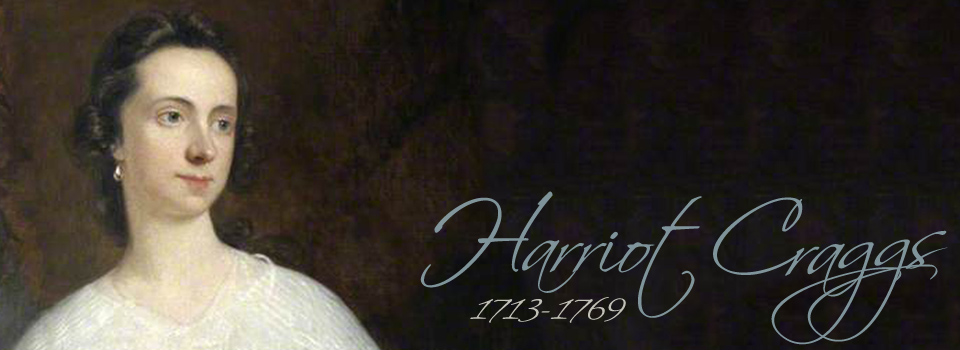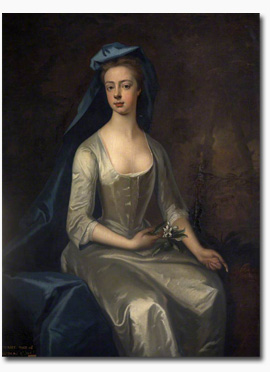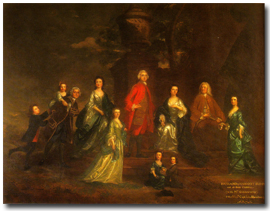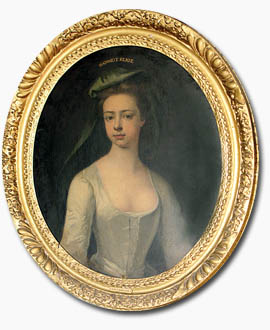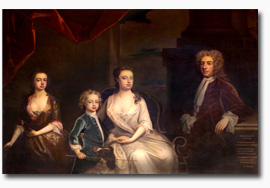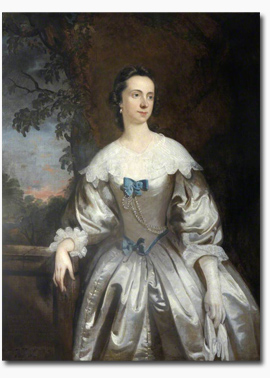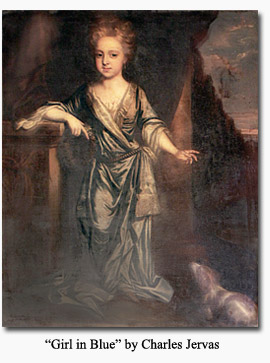Harriot Craggs (1713 - 1769)
Harriot was the natural daughter of James Craggs the Younger, Esq., and Miss Hester Santlow.
The search for Harriot Craggs, the child, has raised questions and provided few answers, speculation the only offering available at this time. Nothing is really known about Harriot's birth or childhood. For more than two hundred years after her death, her parentage was glossed over by the Eliots of Port Eliot. She was always referred to as "the natural daughter of James Craggs", her mother ignored and/or scratched out of family trees. This page stands as a modern memorial to the memory of a loving mother and the Christian matriarch of the Port Eliot family (including all of the Earls of St. Germans).

Harriot's mother was the renowned Miss Hester Santlow (later Mrs. Barton Booth), a young dancer and actress in London during the first part of the 18th century. Although she later rose to fame and fortune in her theatrical career, Hester was still on her upward climb at the time of little Harriot's birth. For two years or so before this, Hester had been the mistress of James Craggs the Younger, a notorious playboy and rising politician. She became pregnant and left London in September 1712, returning to the stage one year later. Harriot later recorded, in the Eliot family Bible, her age at the time of her marriage as "13 years and one month", which calculates to February 1713. The exact date and place of her birth are still a mystery, because no one knows where Hester Santlow went during the year's leave of absence. It would be safe to presume that there is a baptism record somewhere for baby Harriot, but it is just as safe to presume that she was baptised under an assumed last name (most likely that of "Smith", under which name she was later married). It is also highly probable that Harriot's mother relinquished her child to the care of the Craggs sisters soon after birth, since Hester returned to a fulltime stage career just seven months later. (The relationship between mother and child remained strong, however, until the early death of Harriot; and much-loved Hester was a very real presence in the lives of her grandchildren. It is obvious that only the baby's well-being was ever-present in the hearts of all concerned.)

James Craggs had, obviously, "acknowledged" his daughter, as there never appears to have been any doubt in the minds of his three sisters about her true parentage. (Interestingly enough, Harriot was the only child ever acknowledged by the sisters of James Craggs, even though he did have at least one other natural child.) Harriot's father died of smallpox in 1721, intestate, when Harriot was just eight years old and, presumably, living among the family of his sister, Anne. Harriot was included in a 1720s family portrait, with her paternal Uncle John and Aunt Anne (nee Craggs) Knight and her aunt's young son by a previous marriage. They obviously considered Harriot as one of the family, for – while James Craggs' estate fell, legally, to his sisters, as did the vast estate of their father, shortly thereafter, when Craggs the Elder died one month later – she inherited a substantial fortune from her father, which sum was possibly increased by property or money from her grandfather's estate. In fact, the vast Craggs fortune would eventually end up – in its entirety – in the hands of Harriot's offspring at Port Eliot, as a result of her children being the "next of kin".
Even though Harriot was acknowledged by her aunts and raised by the family, Harriot was not entitled to use her father's surname unless: (1) she married into a moneyed family of rank, at which point she would be automatically and immediately allowed to use her father's surname as her own; or (2) if she had never married, she might still have been permitted to use the name, depending on the strength of her connection with her father's family and with their permission. While many natural children would never have been allowed to take their father's name, the "rules" were not as fixed at this time and, where fortune or titles existed, the upper classes were "flexible enough to make exceptions".

Harriot's marriage to Richard Eliot was, obviously, arranged. Although they did grow to love each other, there were more than personal feelings involved in this union. Richard was nearly thirty-two years old at the time, Harriot just "thirteen and one month". There is no doubt as to how they could have met, since they were related through the marriage of Richard's older brother and Harriot's aunt, Elizabeth Craggs, when Harriot was just five years old.
On March 4, 1726, Richard Eliot and Harriot "Smith" applied for a marriage license. Six days later, on the tenth day of March, they were married at Lincoln's Inn Chapel in London. The marriage was a great benefit to both parties, since Harriot was now legally entitled to claim her parentage, and Richard would receive his bride's fortune. No exact figure seems to have been recorded, but her "gilt and gesso" wedding chest still stands in the hall at Port Eliot. (Now one of only three such chests in a private collection, the gilt, when polished and new, would have given the chest the appearance of being solid gold. Displayed on the lid are the arms of both Eliot and Craggs.) Four months after her marriage, on 16 Jul 1726, Harriot was granted her own Arms, which were "Impaled with her said Husband's, in lieu of those descended unto her from her Father." Never again would Harriot use the maiden name of Smith, and her sons (upon inheritance of the Craggs estate) would bear the combined names of Harriot and Richard and be legally known as "Craggs Eliot".

Richard and Harriot Eliot were blessed with nine children: three sons and six daughters. Their first child and heir, Edward (later 1st Lord Eliot), was born in July 1727 (when Harriot was but fourteen years old), the last in October 1743. The bond of love between Harriot and her children was never strained – she must have been a remarkable mother. Everyone who knew her loved and admired her – her portraits show a seemingly dimunitive person with sensitive eyes and a resemblance to her mother.
Harriot's life was filled with more than a person's "normal share of sorrow". She and Richard lived to see three of their nine children buried. Their fifth child, a beautiful baby girl called Hester (in honor of Harriot's mother), was buried in the family vault at St. German's Church in 1736, just thirteen months after her birth. How happy the parents must have been the following year, when another little daughter was born and baptized with the name of Augusta. (Through Richard's position as Surveyor General of the Duchy of Cornwall, the Eliots were a part of the household of the Prince of Wales, as well as being intimate friends with the Prince's new German bride, Princess Augusta. It was after her that their daughter was named, and the Princess acted as Godmother.) This time, heartbreak came to Richard and Harriot in just five short months, when little Augusta was laid to rest beside her sister. Ten years later, in the spring of 1747, word arrived relating the sudden death of thirteen-year-old midshipman Dick, and sorrow once again descended on Port Eliot.
After this, however, there was no ten-year break in Harriot's sadness. She would have still been in mourning for Dick when her ailing husband called their eldest son and heir home from his continental "Grand Tour" to settle estate affairs before the father's imminent death. These business transactions necessitated a quick flight to London for father and son, and it was there that Richard breathed his last breath – away from Port Eliot and his beloved family – in November of 1748. Directly after receiving the news from Edward (who was still in London), Captain John Hamilton, a very close family friend, wrote that Harriot and her daughters were coping as well as could be expected, but that her "tenderness has at different times burst out in Floods of Passion". Richard's remains were brought home and buried on the grounds at Port Eliot, and Harriot had some difficult days ahead of her. It appears, from a few of the family letters, that she may have taken the younger girls and gone to live in London on Jermyn-street, but whether she had given up Port Eliot entirely is unclear.

A silver lining in the grey cloud appeared in the form of Captain Hamilton. He had been like one of the family for many years and dearly loved the Eliot children. In August of 1749, he made an offer of himself and his fortune "unreservedly devoted" to Harriot and her children, and Harriot accepted. On 20 Nov 1749, one year and a day after Richard's death (as soon as was respectably possible, and the day after deep mourning would have been put aside), Mrs. Harriot Eliot married Captain John Hamilton. The pair travelled to the church of the Holy Trinity in Cookham (Berkshire county) to be married by the groom's brother and vicar of the church, the Rev. George Hamilton.
Harriot's time was now divided between London and Port Eliot, with possible journeys into Ireland, where Captain Hamilton's elder brother (8th Earl of Abercorn) held the large family estate. The Captain was on half-pay, as was common in time of peace for officers of independent means, and the first six years of their married life must have been filled with happy times. A daughter was born to them during those years, but the baby's Christening record has not cropped up in any of the usual places. (Perhaps she was born in Essex county or Ireland, where records are scarce.) The memory of these sweet days were a blessing that would have to carry Harriot through another "vale of the shadow of death", for the Captain was called back to active duty in February 1755 – another war with France had begun (known to history as the Seven Years' War).
British Admiralty records were carelessly (if at all) kept, neglectfully collected, destroyed, stored incorrectly, and now stand woefully incomplete and in a state of utter confusion. The movements of the Lancaster during those first months has been lost to time, but the Captain is aboard ship on 09 Aug 1755 to write his will – the most beautiful declaration of love which ever passed through the halls of any probate court – leaving the guardianship of his "infant daughter Ann" to his "most dear, most respected, and most entirely real beloved wife". Captain Hamilton spent some time with Harriot near the end of September, but he must have sailed soon after and was gone long enough to be impatient to return to her and the baby (waiting for him London).
On 18 Dec 1755 – imagine one small boat, the stormiest of weather, and nine men struggling against wind and wave – the righteous Captain Hamilton drowned in Portsmouth Harbour. Harriot was waiting for him in London and may or may not have known that she was carrying their second child, a healthy little boy. An unknown Gentleman from Portsmouth headed straight to Harriot with the news of her husband's death. No good imagination is needed to envision the horror and grief which struck the enceinte Harriot. The grace of God carried her through the following days and weeks, and John James Hamilton was born in London on 02 July 1756 – seven months after his father's tragic death. Harriot's sorrow must have been brought home again by the absence of the sure-to-have-been-proud father; it would have been difficult to balance a home both deep in mourning and celebrating the birth of a new baby. At the age of 42, having already buried two husbands and three children, Harriot found herself living in London (near her precious Mother) with two infant children and a family spread around the country.
Harriot was not in good health during the last years of her life. She continued to visit her older children and her mother, saw four of her children marry, rejoiced at the births of ten grandchildren, and sorrowed at the deaths of two infant grandsons. Throughout this time, she was busy raising her younger children and – sadly – burying one of them. Nine years after the death of her second husband, Harriot buried their daughter, Anne.
On 31 Jan 1765, shortly after the death of her daughter, Harriot wrote a will from her home in Highgate, London, giving detailed instructions for the guardianship of her nine-year-old son, John Hamilton. Four years later, on 20 Jan 1769, Harriot was down in Plymouth adding an interesting codicil to her will. This included special bequests of personal items such as the "Family Conversation Piece by Reynolds" (being the group portrait), two "fine old family Bibles", and two large "India Bowls" to her eldest son, Edward. She also directed that she was to be buried "outside the Chancel Window of St. German's Church that looks into the Port Eliot Garden" – the same spot where her first husband, Richard Eliot, must have been buried in 1748.
Just twelve days after writing this codicil, on 01 Feb 1769, Harriot Hamilton went to her blessed home in heaven and, according to parish records (which may or may not be correct), was buried the same day. Her coffin rests in the brick vault below the window, overlooking the garden that she loved.
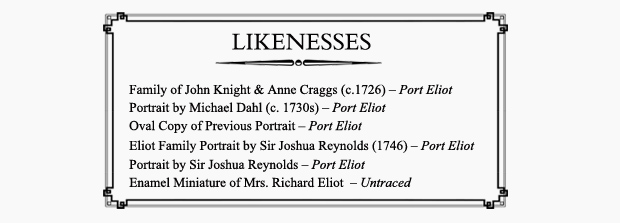
There are six known portraits of Harriot Craggs. Harriot appears in the c. 1726 family portrait by Thomas Hudson with her Uncle John & Aunt Anne Knight and cousin James Newsham. She was painted twice by Reynolds, once as part of the famous Eliot family group in 1746, and in a single portrait dating to 1748-55. Another fine portrait by Michael Dahl, with a copy of this same likeness hanging in a small oval frame. The latter has been wrongly attributed to Sir Godfrey Kneller, as it is a copy of the larger Michael Dahl portrait. All five of these portraits currently hang at Port Eliot. The last of the known portraits of Harriot Eliot is an enamel miniature (by an unknown artist), last known to be in the collection of the Baroness Burdett-Coutts in 1891.
There is, hanging at Port Eliot, a painting by Charles Jervas of a little girl in a blue dress. While listed as "unknown sitter" for many years, it seems quite possible that it is a very early portrait of Miss Harriot "Smith" Craggs. The features are unmistakably Harriot's, and it was probably commissioned by one of her Craggs aunts.

A number of Harriot's letters have survived the test of time, most of them written to her eldest son, Edward (later 1st Lord Eliot). Commenting on these, her great-great-grandson, William Eliot (4th Earl of St. Germans), stated that they were "remarkably good specimens of such literature, and the spelling is very superior to that found in the correspondence of many great ladies in the time of Mrs. Delany".
